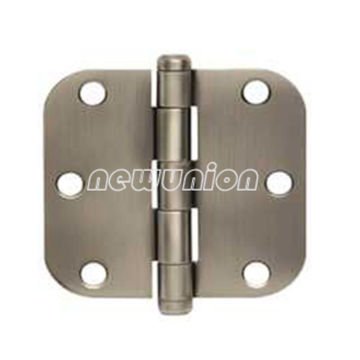
Imagine you’re explaining this over coffee with a friend. You might start talking about how round corner hinges are often seen as more forgiving—like a gentle hug—while square corner hinges can provide a sharper, more precise look. Each type has its own unique attributes, and understanding these can save you from some headaches down the line. Let’s break down the details, so you can feel confident in your hinge choice.
Round corner hinges, as the name suggests, have rounded edges. This design isn’t just for looks; it serves several practical purposes too. Typically found in residential applications, they’re popular for doors that need to blend seamlessly into their surroundings.
The rounded edges can make them safer, especially in homes with children running around. Think about it: sharp corners can lead to unexpected bumps and bruises, whereas round corners offer a bit more protection. This might be why you see them often on cabinets or doors in family-friendly settings.
In terms of installation, round corner hinges are generally more forgiving. Since they can pivot smoothly, they’re able to accommodate slight misalignments during installation—this can be a blessing if you’re not a seasoned DIYer. Additionally, they allow for a smoother operation, which can be crucial in high-traffic areas like kitchens or playrooms.
Now, let’s take a look at square corner hinges. These guys are all about precision and a clean, modern look. With their sharp, distinct edges, square corner hinges often appeal to those going for a more contemporary design. They fit snugly into corners and provide a more defined appearance, which can make a striking difference in visual aesthetics.
One key benefit of square corner hinges is their strength. They typically handle heavier doors better than their rounded counterparts. So, if you’re working on a solid wood door or a heavy exterior door, square corner hinges might be the way to go. They’re designed to withstand greater stress, ensuring your door operates smoothly for years.
When it comes to installation, square corners require a little more accuracy. You’ll need to ensure everything lines up perfectly for the best performance. If misalignment occurs, it might affect how well the door swings or latches, which can be frustrating.
Round corner hinges are versatile in their applications. You’ll most likely find them in residential settings, particularly in cabinets, interior doors, and lightweight doors. They’re great for places where the aesthetic flow is essential, and safety is a priority.
If you’re an organizer at heart, think about using round corner hinges in your kitchen cabinets. They’ll not only enhance the look but also allow for smooth operation—no more getting caught on sharp edges while reaching for that spice jar! They’re also a favorite for children’s furniture, where safety is a top concern.
In commercial applications, round corner hinges can also be seen in lightweight doors or areas where safety is paramount. Schools, daycares, and hospitals often prefer them for their gentle approach to design.
Square corner hinges often shine in more robust applications. You might encounter them on exterior doors, high-traffic commercial doors, or even garage doors. Their ability to bear weight makes them an excellent choice for front doors that need to withstand the elements.
They’re also popular in industrial settings. Imagine a large warehouse door that opens and closes multiple times a day; square corner hinges can handle that heavy usage without breaking a sweat. Their durability ensures that the door remains functional, even after years of heavy use.
In residential settings, square corner hinges can elevate the look of your home. If you’re after a sleek, modern vibe, you’ll likely want these hinges for your main doors. They provide crisp lines and a streamlined appearance, enhancing your home’s overall aesthetic.
Durability is one of the main factors to consider when choosing between round corner and square corner hinges. Square corner hinges typically win this round. Made from thicker materials and designed for strength, they excel in demanding situations.
That said, round corner hinges aren’t fragile. They are reliable for lighter doors and applications, but you should expect them to eventually show wear if subjected to heavy use. Choosing the right hinge depends on your specific needs.
For example, if you’re fitting a heavy front door, opt for square corner hinges. If you’re upgrading kitchen cabinet doors, round corner hinges can do the trick without weighing them down.
When it comes to cost, both types of hinges can vary widely based on materials, sizes, and brands. Generally, round corner hinges tend to be a bit cheaper, making them a budget-friendly option for light-duty applications.
On the other hand, square corner hinges often come with a higher price tag, and that’s mainly due to their robust construction and durability. If you’re investing in a high-traffic door, that cost can be worth it for the longevity they provide.
It’s essential to balance your budget with the requirements of your project. Sometimes spending a bit more upfront can save you from frequent replacements down the line.
Installing round corner hinges tends to be more forgiving. Their rounded edges allow for minor adjustments without significant issues. This is fantastic news for DIYers who may not have extensive experience but want to get the job done.
On the flip side, installing square corner hinges requires a careful hand. You’ll need precise measurements and cuts to ensure a snug fit. Misalignment can lead to doors that stick or don’t close properly. If you’re up for a little challenge and want that modern look, though, it might be worth the effort.
Before you begin installation, gather your tools and plan your approach. Having a clear idea will make the process smoother, regardless of which hinge type you choose.
To sum it up, whether you lean towards round corner or square corner hinges largely depends on the project at hand. Consider factors like aesthetics, weight capacity, and ease of installation. Ultimately, choosing the right hinge type can enhance both the functionality and style of your doors or cabinets. Happy building!